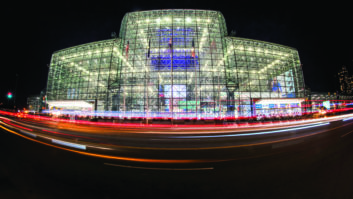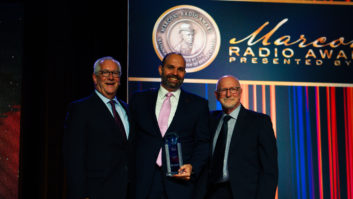NAB President and CEO Curtis LeGeyt says broadcasters will have to leverage the screen and mobile experience in the car in order for radio to reach its full potential over the next decade.
Appearing on the Borrell Local Marketing Trends Podcast this week — where he took the 10-Year Challenge projecting where radio will be in a decade — the leader of the NAB acknowledged that the broadcast industry is in a period of extreme disruption.
“From the broadcast perspective we are seeing what is happening in the media landscape and the various ways consumers are accessing media content. All of that has been upended by new technologies, so there is a lot of work ahead,” LeGeyt said during the podcast.
When LeGeyt looks at 2032 he sees local radio offering a proliferation of ways for listeners to find adjacent programming streams, podcasts, station apps and subchannels.
“All of that will be fueled by what is happening in the dashboard. It will all be packaged. It will all be easily accessible for the listener,” LeGeyt said. “Increasingly, the experience in the car is a screen-driven experience. There is a lot of real estate for radio to work with, building that relationship with the listener and expanding the relationship across various brands.”
[Visit Radio World’s News and Business Page]
The radio industry is continuing to focus on building out the screen, LeGeyt said. “I think 10 years out it is the screen driven experience for radio broadcasters and those broader audio platforms that will be a real differentiator. What I think will change about radio is [that] a local radio station will be able to build its brand beyond just the traditional AM and FM signal.”
The challenges facing radio are many, as pointed out on the Burrell Local Marketing Trends Podcast. In-car systems like Apply CarPlay and Android Auto bring more immersive screen-driven experiences for listeners with more options. But there are bigger worries facing radio broadcasters and standing in the way of future success, LeGeyt says.
“The real bogeyman to me is the fact that Congress is always slow when it comes to adapting it laws, especially when it comes to telecom, and to adapt to what is happening in the marketplace. What I worry about is the problem everyone can see. Broadcasters are effectively competing with one arm tied behind our back against the tech platforms and other media that have a national scale.”
[Related: “World Car Tech Trends Offer Risks and Opportunities to Radio“]
LeGeyt, who took over the leadership role at NAB earlier this year, continued: “There are several resolutions possible. One is allow broadcasters to compete and gain that scale. Congress looks at media ownership laws and does some modernization there that is long overdue as far as national ownership cap. As well as the scale that can be gained to the benefit in investment in localism by increasing ownership in local markets. The other is the regulation of big tech.”
As for the future of media consumption, LeGeyt said on the Borrell podcast he believes local broadcast will be an important part of bringing communities together and combating social media disinformation and cable news politicization.
“I think some of these technological innovations and media opportunities are symptoms of what is happening in society. I don’t look at them as enemies of radio on a technology basis, but rather the trends that (the FCC) is allowing to proliferate are bad for democracy. And I think they create a lot of unhappiness,” LeGeyt said.
Therefore, local broadcasters need to double down on fact-based information, LeGeyt says, at a hyper local level.
“We’ve seen the demise of newspapers. Yet, there are business opportunities for radio and TV to fill the role of local newspapers. They have the local, trusted personalities to help bridge divides.
“Radio’s advantage is live and local and I believe radio will continue to thrive in that regard. Whether they are distributing programming through a traditional terrestrial AM or FM signal, or whether the content is being consumed through a stream or an adjacent podcast,” LeGeyt said.
Borrell Associates CEO Gordon Borrell pointed to data during the podcast that showed more media buyers gearing up to spend more on social media advertising and banner ads, with fewer planning to sink dollars into radio going forward. “Radio is at about half the rate of social media,” Borrell said. “Only newspaper is further down the list than radio and TV.”
LeGeyt, however, remains optimistic that broadcast radio — through further diversification of audio platforms — will present advertisers a unique opportunity.
“There will be new business opportunities and partnerships with local advertisers. I think there is a lot there for local broadcasters to build-out that screen (to increase revenue),” LeGeyt said.











